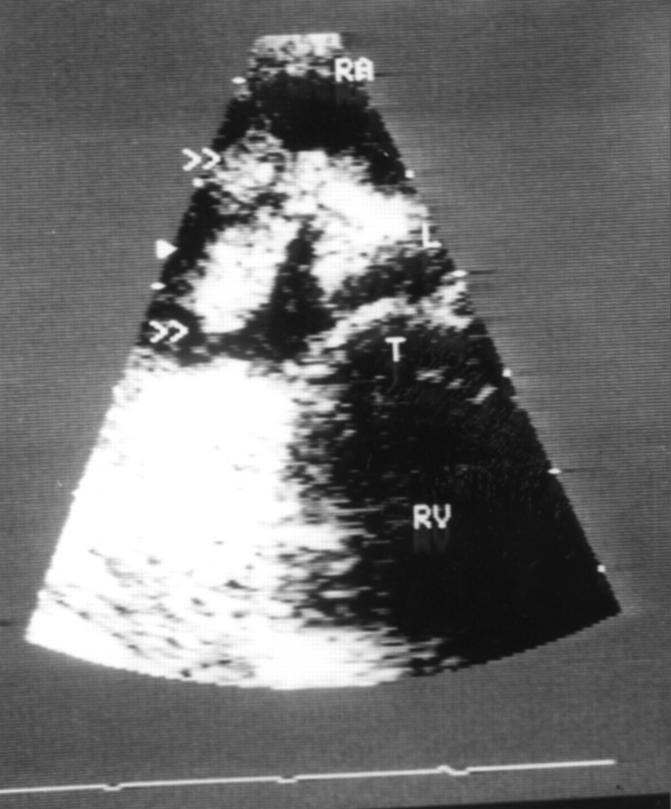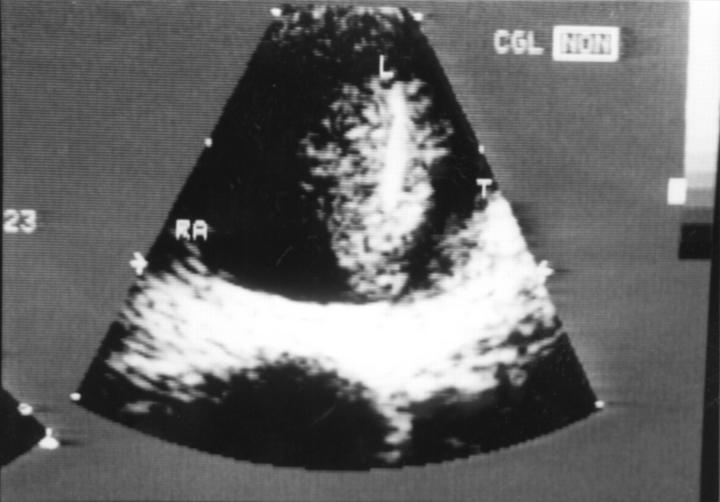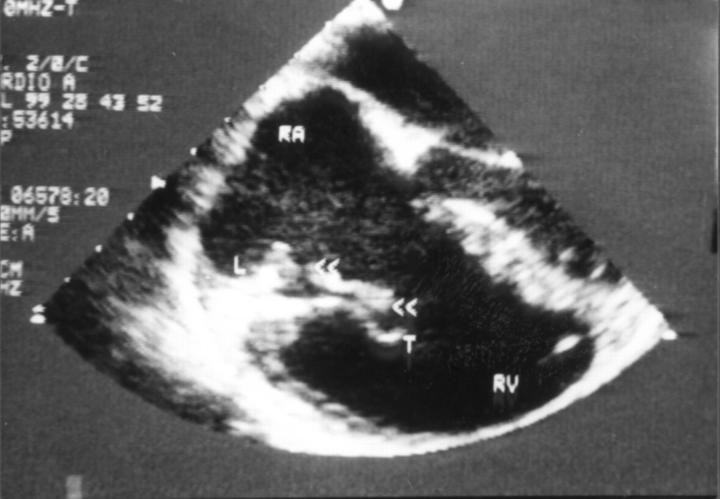Abstract
Objective—To compare transthoracic and transoesophageal echocardiography (TTE, TOE) in patients with permanent pacemaker lead infection and to evaluate the safety of medical extraction in cases of large vegetations. Methods—TTE and TOE were performed in 23 patients with definite pacemaker lead infection. Seventeen patients without previous infection served as a TOE reference for non-infected leads. Results—TTE was positive in seven cases (30%) whereas with TOE three different types of vegetations attached to the leads were visualised in 21 of the 23 cases (91%). Of the 20 patients with vegetations and lead culture, 17 (85%) had bacteriologically active infection. Left sided valvar endocarditis was diagnosed in two patients. In the control group, strands were visualised by TOE in five patients, and vegetations in none. Medical extraction of vegetations ⩾ 10 mm was performed in 12 patients and was successful in nine (75%) without clinical pulmonary embolism. After 31.2 (19.1) months of follow up (mean (SD)), all patients except one were cured of infection; three died from other causes. Conclusions—Combined with bacteriological data, vegetations seen on TOE strongly suggest pacemaker lead infection. Normal TTE examinations do not exclude this diagnosis because of its poor sensitivity. Medical extraction of even large vegetations appeared to be safe. Keywords: pacemaker lead infection; transoesophageal echocardiography
Full Text
The Full Text of this article is available as a PDF (133.9 KB).
Figure 1 .
Transoesophageal echocardiography showing a type 1 vegetation close to an intact tricuspid valve. Note the flattening of the atrial lead. L, lead; RA, right atrium; RV, right ventricle; T, tricuspid valve; >> indicates the vegetation.
Figure 2 .
Transoesophageal echocardiography showing a type 2 vegetation in the right atrium surrounding the atrial lead and adjacent to the tricuspid. L, lead; RA, right atrium; T, tricuspid valve.
Figure 3 .
Transoesophageal echocardiography showing a type 3 vegetation in the right atrium close to the tricuspid valve but without valvar endocarditis. L, lead; RA, right atrium; RV, right ventricle; T, tricuspid valve; >> indicates the vegetation.
Selected References
These references are in PubMed. This may not be the complete list of references from this article.
- Bayer A. S., Ward J. I., Ginzton L. E., Shapiro S. M. Evaluation of new clinical criteria for the diagnosis of infective endocarditis. Am J Med. 1994 Mar;96(3):211–219. doi: 10.1016/0002-9343(94)90144-9. [DOI] [PubMed] [Google Scholar]
- Bluhm G. Pacemaker infections. A clinical study with special reference to prophylactic use of some isoxazolyl penicillins. Acta Med Scand Suppl. 1985;699:1–62. [PubMed] [Google Scholar]
- Camus C., Leport C., Raffi F., Michelet C., Cartier F., Vilde J. L. Sustained bacteremia in 26 patients with a permanent endocardial pacemaker: assessment of wire removal. Clin Infect Dis. 1993 Jul;17(1):46–55. doi: 10.1093/clinids/17.1.46. [DOI] [PubMed] [Google Scholar]
- Conklin E. F., Giannelli S., Jr, Nealon T. F., Jr Four hundred consecutive patients with permanent transvenous pacemakers. J Thorac Cardiovasc Surg. 1975 Jan;69(1):1–7. [PubMed] [Google Scholar]
- Freedberg R. S., Goodkin G. M., Perez J. L., Tunick P. A., Kronzon I. Valve strands are strongly associated with systemic embolization: a transesophageal echocardiographic study. J Am Coll Cardiol. 1995 Dec;26(7):1709–1712. doi: 10.1016/0735-1097(95)00394-0. [DOI] [PubMed] [Google Scholar]
- Klug D., Lacroix D., Savoye C., Goullard L., Grandmougin D., Hennequin J. L., Kacet S., Lekieffre J. Systemic infection related to endocarditis on pacemaker leads: clinical presentation and management. Circulation. 1997 Apr 15;95(8):2098–2107. doi: 10.1161/01.cir.95.8.2098. [DOI] [PubMed] [Google Scholar]
- Kugener H., Rey J. L., Tribouilloy C., Hermida J. S., Jarry G., Avinée P., Maingourd Y. Endocardites infectieuses sur sondes de stimulation endocavitaire permanentes: intérêt de l'échocardiographie et revue de la littérature. Ann Cardiol Angeiol (Paris) 1993 Jun;42(6):331–338. [PubMed] [Google Scholar]
- Lewis A. B., Hayes D. L., Holmes D. R., Jr, Vlietstra R. E., Pluth J. R., Osborn M. J. Update on infections involving permanent pacemakers. Characterization and management. J Thorac Cardiovasc Surg. 1985 May;89(5):758–763. [PubMed] [Google Scholar]
- Orsinelli D. A., Pearson A. C. Detection of prosthetic valve strands by transesophageal echocardiography: clinical significance in patients with suspected cardiac source of embolism. J Am Coll Cardiol. 1995 Dec;26(7):1713–1718. doi: 10.1016/0735-1097(95)00375-4. [DOI] [PubMed] [Google Scholar]
- Phibbs B., Marriott H. J. Complications of permanent transvenous pacing. N Engl J Med. 1985 May 30;312(22):1428–1432. doi: 10.1056/NEJM198505303122205. [DOI] [PubMed] [Google Scholar]
- Van Camp G., Vandenbossche J. L. Recognition of pacemaker lead infection by transoesophageal echocardiography. Br Heart J. 1991 Apr;65(4):229–230. doi: 10.1136/hrt.65.4.229. [DOI] [PMC free article] [PubMed] [Google Scholar]
- Victor F., de Place C., Leclercq C., Camus C., Gras D., Le Helloco A., Laurent M., Laporte J., Mabo P., Daubert C. Infections sur sonde de stimulation endocavitaire permanente: intérêt de l'échocardiographie transoesophagienne. Arch Mal Coeur Vaiss. 1995 Dec;88(12):1875–1881. [PubMed] [Google Scholar]
- Vilacosta I., Sarriá C., San Román J. A., Jiménez J., Castillo J. A., Iturralde E., Rollán M. J., Martínez Elbal L. Usefulness of transesophageal echocardiography for diagnosis of infected transvenous permanent pacemakers. Circulation. 1994 Jun;89(6):2684–2687. doi: 10.1161/01.cir.89.6.2684. [DOI] [PubMed] [Google Scholar]
- Vilacosta I., Zamorano J., Camino A., San Román J. A., Rollán M. J., Pinto A. Infected transvenous permanent pacemakers: role of transesophageal echocardiography. Am Heart J. 1993 Mar;125(3):904–906. doi: 10.1016/0002-8703(93)90194-e. [DOI] [PubMed] [Google Scholar]
- Zehender M., Büchner C., Geibel A., Kasper W., Meinertz T., Just H. Diagnosis of hidden pacemaker lead sepsis by transesophageal echocardiography and a new technique for lead extraction. Am Heart J. 1989 Nov;118(5 Pt 1):1050–1053. doi: 10.1016/0002-8703(89)90244-5. [DOI] [PubMed] [Google Scholar]





